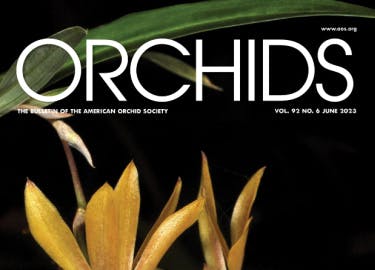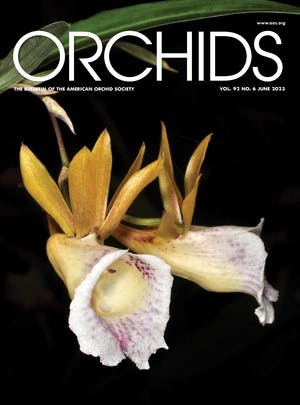
” Prior to this time, the intriguing species of this genus were included in Masdevallia with about 623 species. Today approximately 134 species found in moist forests are recognized, mostly in western Colombia and Ecuador. Some species have been found in Costa Rica and Nicaragua. In the wild, they thrive in cool, montane cloud forest at elevations of 4,500 to 6,500 feet (1,400–2,000 m).
All members of the genus Dracula have long, slender tails on their sepals, thus the dragon-like appearance. The apices of the short petals have a warty texture that can give the appearance of two eyes on either side of the nose-like column. Draculas are popular in hobbyist collections and many species and hybrids are now in cultivation.
All members of the genus Dracula have long, slender tails on their sepals, thus the dragon-like appearance. The apices of the short petals have a warty texture that can give the appearance of two eyes on either side of the nose-like column. Draculas are popular in hobbyist collections and many species and hybrids are now in cultivation.
This article shares my experiences growing draculas in my artificial environment and not in their natural habitats or in biological, botanical or horticultural studies. Furthermore, it deals with my fundamental cultural experience of this genus accumulated over about 20 years. Currently, over 90 dracula species “live” in my small greenhouse.
[1] The author’s growing area.

Draculas are referred to in the vast majority of publications as either “cold” or “cool-growing” plants, as the natural habitats are located primarily in the Andes of Colombia, Ecuador and Peru. Those species found in Costa Rica and Nicaragua are found at correspondingly lower elevations.
In Europe, these plants are usually obtained from nurseries that have been growing them for years in their artificial environments and have further propagated them by division, thus acclimating them to our climates, which decidedly lack cool summers.
Even direct imports by Ecuagenera, the best-known dracula exporter in Ecuador, come from temperate climates. Cuenca, the location of Ecuagenera’s temperate location, is at 8,400 feet (2,550 m) and has temperatures above 86 F (30 C), occasionally over longer periods. This nursery also grows so-called “warm-growing” orchids for worldwide distribution. In addition, the natural habitats of many dracula species are below this elevation.
[2] Dracula amaliae

[3] Dracula chestertonii

It is also true that they can be grown at a temperature of 47 to 54 F (8–12 C) during the winter months, as I do for energy saving reasons. However, even a few degrees warmer should not be a problem. Difficult to imagine, however, is a winter location in a centrally heated “flower window!”
What I am striving to convey here is that for successful culture of draculas, it is not so much the absolute temperature that is important, but the need to ensure constantly high humidity, never falling below 60 percent RH for all but very short periods and, ideally, it should be maintained between 70 and 85 percent. This is usually achieved with frequent spraying of the plants and an absolutely shady location from spring to autumn. It is also recommended to install an ultrasonic fogger, which can be done these days for relatively little money. In the case of greenhouse culture, I would strongly recommend the installation of a small fogging system controlled by a timer, which, if installed yourself, is also an inexpensive and effective project.
For many years I grew my draculas outdoors in a shady location from summer to late fall, until the summers of 2019 and 2020, when the limits of this practice were reached. During these two summers in the Lower Rhine in Germany, we had temperatures at times up to 104 F (40 C) and weeks of drought. Although I was able to avoid plant losses by frequent fogging with reverse osmosis-purified water, hardly a bud made it to bloom. So, I decided to buy a small greenhouse with a small fogging system and sufficient air circulation. Lo and behold, the flower yield was phenomenal — despite the high temperatures. However, a room with north or eastern exposure where the humidity could be kept sufficiently high would have provided a similar environment.
[4] Dracula antracina

[5] Dracula cordobae

[6] Dracula chimaera

[7] Dracula cutis-bufonis

[8] Dracula dodsonii

[9] Dracula agnoisia

SUBSTRATE
First, it needs to be mentioned that I have almost no experience with draculas grown in bark mixtures, although some growers achieve quite good results with such a medium. I have grown my draculas for many years in a 1:1 mixture of New Zealand sphagnum moss and washed coconut chips and I repot annually. I soak the moss and chips overnight in plenty of rainwater, reverse osmosis or distilled water and then dispose of the resulting brown broth.
Draculas have a great advantage over most other orchid genera in that you cannot overwater them. They like to be kept permanently moist to even wet. On the contrary, prolonged drying ends with the loss of the plant. Try to imagine that in their natural habitats as cloud forest inhabitants, for the most part, they grow in constantly wet moss cushions over stones, rocks and on tree trunks and some species are even found as terrestrials. So, we should not be afraid to thoroughly immerse draculas in water, especially
WATER
Draculas need extremely low salt concentrations for healthy growth. When I started to grow more draculas about 20 years ago, I read in a “smart book” that, as a rule of thumb, these orchids should be watered with a salt content of about 80 μS (about 40 ppm total dissolved solids [TDS]) [microsiemens = measuring unit for determining the salt content in liquids], and fertilized with solutions of 120–130 μS (about 60–65 ppm TDS] every three-to-four weeks. I have held to this regimen with great success. Water used for spraying or misting the plants should also have these values. Therefore, I consider the acquisition of a conductance device that measures in μS, from my point of view, indispensable. This is not limited to draculas but will benefit other orchid genera as well, except with different limits — 150 and 450 μS (about 75 and 225 ppm), respectively. A conductivity meter is not only useful for determining the upper limits of water quality but is indispensable for adjusting the conductivity of reverse osmosis water or rainwater, which may have even a lower conductivity depending on atmospheric conditions and how it is collected. A properly working reverse osmosis unit typically puts out water in the range of 30–60 μS (25–30 ppm) depending on the make and age of the membrane (water of even greater purification is possible with the correct configuration but usually an unnecessary expense in terms of hardware costs and rejected water stream), which must be adjusted upward to the desired 80 μS (~ 40 ppm) by the addition of small quantities of fertilizer (preferably chemical-free biofertilizer) so as not to deprive the plants of nutrients. Using tap water requires the opposite adjustment — addition of distilled water to reduce electrical conductivity to the desired 80 μS. As an aside, regular measuring water conductivity of your reverse osmosis system provides the first warning that the membranes are reaching the end of their useful life. As the membranes age, the conductivity of the purified water stream will begin to creep upward signaling the breakthrough of undesirable ions — typically sodium ions, which are toxic to plants under the right conditions.
[10] Dracula aphrodes

[11] Dracula vampira

[12] Dracula Raven (vampira × roezlii)

[13] Dracula astuta

[14] Dracula Nightshade (vampira × robledorum)

[15] Dracula venifica

[16] Dracula roezlii

POTS
The vast majority of dracula species and hybrids produce pendent or decumbent inflorescences, which mandates the use of mesh pots or wooden baskets to allow the inflorescences to emerge unimpeded. Personally, I use only plastic mesh pots. Wooden baskets are decorative but not exactly space-saving nor inexpensive. Mounting on porous clay pots that are designed to wick water keeping the root zone constantly moist, cork and wooden supports with added moss, and treefern slabs are also popular and decorative variants, although the latter three require continuous attention moisture level.
Of course, draculas can also be cultivated successfully in terrariums and Wardian cases. Because I have no experience with such conditions, I will leave these to people with personal experience. But as I hear often, air circulation is a special problem to prevent fungal damage and bacterial disorders.
In my greenhouse, I use an exhaust fan that runs at hourly intervals day and night, providing cooling and fresh air. Two-stage fans are useful as they can be set to turn on at higher velocities during hot summer days. During the winter, much of the area of the intake side is covered leaving a gap of around 4 inches (10 cm) to minimize cold drafts.
[17] Dracula carcinopsis

[18] Dracula pileus

[19] Dracula erythrycodon

[20] Dracula gorgona

[21] Dracula sibudoyensis

[22] Dracula cochliops

[23] Dracula wallisii

LIGHT Draculas have thin foliage and direct sunlight should be avoided as much as possible, especially during periods of warm weather. Depending on your location, winters can be quite dark in addition to the short days, and draculas will benefit from the addition of supplemental light until about mid-March. The western side of my greenhouse (faces the sun) has painted-on shading compound so that from the beginning of October until middle to end of March, I supplement the natural light using LED daylight fixtures that are turned on an off automatically for over 12 hours a day and during dark, longer rainy periods in the spring and late summer, these can be turned on manually as needed.
These are fascinating and rewarding plants given a bit of attention to their specialized needs. I hope this article entices some of you to give them a try and wish you the greatest possible success with this wonderful genus.
Acknowledgement
Thank you to Judith Rapacz-Hasler for the introduction and translation from German to English.
Further reading Luer, C.A. 1993. Icones Pleurothallidinarum X. Systematics of Dracula. Missouri Botanical Garden. https://powo.science.kew.org/dracula https://de.wikipedia.org/wiki/Dracula_(Orchideen) — Wolf Wanninger, Husarenallee 2, 47803 Krefeld, Germany (email wanninger@buehnen-design.de).











